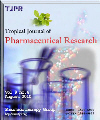
|
Tropical Journal of Pharmaceutical Research
Pharmacotherapy Group, Faculty of Pharmacy, University of Benin, Benin City, Nigeria
ISSN: 1596-5996
EISSN: 1596-5996
Vol. 14, No. 8, 2015, pp. 1323-1332
|
 Bioline Code: pr15174
Bioline Code: pr15174
Full paper language: English
Document type: Research Article
Document available free of charge
|
|
|
Tropical Journal of Pharmaceutical Research, Vol. 14, No. 8, 2015, pp. 1323-1332
| en |
Preparation, Characterization and In vitro Evaluation of Theophylline Nanoparticles Prepared with Dextran- Conjugated Soy Protein
Jin, Bei; Zhou, Xiaosong; Chen, Caiyan; Zhang, Xiaosa & Chen, Siqiao
Abstract
Purpose:
To design and characterize theophylline nanoparticles synthesized with dextran-conjugated
soy protein isolate (SPI), and evaluate their encapsulation capacity and release profile in simulated
gastrointestinal media.
Methods:
SPI-based nanoparticles were prepared with soy protein-dextran conjugates obtained by
titanium dioxide (TiO2) photocatalysis using a simple ionic gelation method. Formation of the conjugates
was monitored spectrophotometrically for free amino group content (A340nm) and by Fourier transform
infrared spectroscopy (FT-IR). The particles were characterized by for particle size and morphology,
zeta potential, and in vitro release.
Results:
Successful glycoconjugation was evidenced by changes in ultraviolet (UV) absorption (A294),
browning, free amino group and FT-IR spectra. The particle size and zeta potential of SPI-dextran
nanoparticles tended to increase and decrease, respectively, with increasing SPI/dextran mass ratio.
Maximum encapsulation and loading efficiencies were around 91.6 and 3.08 %, respectively, which
were significantly higher than for SPI nanoparticles. Successful encapsulation of theophylline in the
polymeric matrix was confirmed by FT-IR spectra. In addition, SPI-dextran nanoparticles reduced
release (p < 0.05) of theophylline in simulated gastric fluid but and enhanced release (p < 0.05) under
simulated intestinal condition.
Conclusion:
These results suggest that SPI-dextran nanoparticle formulation is an attractive approach
to achieve encapsulation and controlled release of bioactive substances.
Keywords
Soy protein; Dextran; Nanoparticles; Encapsulation; Controlled release; Theophylline
|
| |
© Copyright 2015 - Tropical Journal of Pharmaceutical Research
Alternative site location: http://www.tjpr.org
|
|
